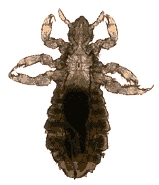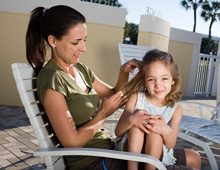Lice Can Be Good For You: The Benefits of Parasites Revealed
by www.SixWise.com
The role of your immune system is to prevent disease, but sometimes your body produces over-active immune responses, and the opposite effect happens, resulting in many of our modern human health problems.

Lice and other parasites may help your immune system to function naturally and reduce your risk of immune dysfunctions like allergies, arthritis and multiple sclerosis. |
Your immune system is actually designed to distinguish between dangerous invaders in your body and its own body cells, but when it mistakenly identifies self proteins for non-self proteins, it initiates an attack on its own body, causing either an allergic response or worse -- autoimmune diseases such as arthritis, asthma, diabetes and multiple sclerosis.
In a study involving wild mice, researchers found a key component to helping the immune system function naturally and therefore potentially reduce the risk of developing immune dysfunctions. What is that beneficial component?
Parasites, particularly lice.
Lice to the Rescue?
According to a study published in the open access journal BMC Biology, louse Polyplax serrata (a form of lice), could help lessen a hyperactive immune system and reduce the risk of developing immune dysfunctions.
“Much like laboratory mice, people in developed countries are currently exposed to a very different profile of infections to that encountered by their ancestors,” said Jan Bradley, professor of parasitology at the University of Nottingham in a Science Daily article. “It is possible that the immune dysfunctions we see today are the result of immune systems molded by evolution for a set of challenges completely different to those encountered in modern times.”
Experts hypothesized that modern humans who evolved in artificial environments may have overactive immune responses due to an overall lack of exposure to parasites throughout their lifetime.
In fact, other beneficial uses for parasites have also recently been uncovered. For instance, researchers are exploring the use of a cocktail of worm eggs to help reduce the symptoms of multiple sclerosis (MS).
Worm Eggs -- A New Remedy for MS
Doctors are at the beginning stages of testing “worm egg mixers” in MS patients in hopes that it will act as another alternative to fighting the degenerative disease.
Another study already showed that the consumption of the worm eggs, also known as helminthes, has proven effective in the treatment of inflammatory bowel disease.
“Because it is a very natural approach, it takes a few weeks until it can unfold its full mode of action to show considerable improvements,” said Detlev Goj, CEO of Ovamed in an ABC News article. “However, this is something we are happy to accept in exchange for lacking such severe side effects most conventional medicines have.”
How the Worm Mixers Work
The potential for success lies in the action of the crucial T-cells in the immune system. Imagine T-cells as microscopic military leaders controlling how they will attack foreign invaders in the body. There are two types of responses, Th1 pattern, where the T-cells call upon a major response from the body’s immune system, and Th2 pattern, a lesser reaction, resulting in less inflammation.
In people suffering from MS, inflammation is already a problem, so inappropriate inflammation attacks the lining of the nerves, causing a slowing of impulses. The neurological effects can affect the quality of vision, speech, walking, writing and memory.
Once the worm mixer hatches inside the intestines, the T-cells that elicit the Th2 pattern are called to action as opposed to the more aggressive Th1 pattern. The result is less inflammation.
Of course, not all parasites are good for the human body. The list of below parasites can affect the human digestive system by taking up temporary residence and attacking the intestines.
Six Human Intestinal Parasites to Watch Out For
-
Giardia -- one of the most common intestinal parasites in the United States that infects around 2.5 million Americans each year. The primary symptom is diarrhea.
-
Hookworm -- Affects approximately 1 billion people and mainly found in tropical and subtropical areas of the world. Symptoms include weight loss, anemia, abdominal pain and diarrhea.
-
Protozoan Infections -- Found predominantly in immigrants and is caused by ingestion of food or water contaminated by the strain of parasite. In some cases, patients may experience loose stools and abdominal pain.
-
Roundworms -- Most common parasitic infection in the world, particularly in rural areas. Most people infected don’t exhibit any symptoms.
-
Strongyloidosis -- Infection happens through direct contact with soil containing larvae that can penetrate the skin and travel to the small intestine. Most people infected don’t display symptoms although in severe cases the patient may experience abdominal pain, nausea, vomiting, diarrhea and constipation.
-
Trichinosis -- caused by the ingestion of raw or undercooked meat. Most people don’t display symptoms, however in severe cases, the patient may experience abdominal pain and aching muscles and joints.
So while some parasites may be beneficial from an evolutionary standpoint, or for specific clinical uses during which their use is closely monitored, many parasites are far from healthy -- or desirable.
An Important Overview of Head Lice
Head lice, parasitic insects that live off of the blood from the scalp, affect some 6 million to 12 million people in America every year, and though it's a year-round problem, outbreaks tend to occur at the beginning of the school year (when kids spend more time in close contact with one another) and when temperatures reach between 75 and 98.6 °F -- the optimum for head lice.
Far from being beneficial, in most human cases head lice are an incredibly itchy and often embarrassing condition.
The most common symptom of head lice is itching, which occurs after a person becomes sensitized to the lice saliva and essentially has an allergic reaction to it as they feed. However, this typically doesn't occur for two or three months after the lice first hit your head, and it's possible to catch one or two lice and not even know that they're there for years!
Most people only realize they have head lice when the itching starts, and by that time there may be a dozen lice on the scalp (typically there are no more than that at any given time). It's because lice can exist on a head for months with no symptoms that schools often perform routine "nit inspections."
Nits are the tiny white eggs that lice lay. Finding nits in the hair, before many lice have hatched, makes it easier to treat the condition and keep it from spreading.
Common symptoms include:
-
An uncomfortable tickling sensation or feeling that something is moving in your hair or scalp
-
Irritability -- urge to scratch the scalp, inability to focus and short temper
-
Small red bumps on the scalp, neck and shoulders
-
Evidence of lice on your scalp and lice eggs on the hair shaft -- sometimes are mistaken for dandruff, however the difference is they can’t be brushed easily out of your hair
Anyone can catch head lice, and contrary to popular belief lice do not prefer “dirty hair.” Instead, they’re usually found on clean healthy scalps and are often spread by:
-
Belongings stored in close proximity -- Items stored closely together such as in school lockers, jackets hanging on side-to-side hooks or home items such as pillows, blankets and stuffed animals can trigger the spread of lice.
Beware of Conventional Lice Treatments -- Many can Lead to Serious Health Risks
One widely prescribed treatment of head lice is Lindane, a treatment that is available as a cream, lotion or shampoo. Lindane is a pesticide that was referred to as “one of the most toxic, persistent, bioaccumulative pesticides ever registered,” by the Environmental Protection Agency (EPA).
Used in Kwell prescription-only lice shampoo, lindane is a neurotoxin that is absorbed through the skin. Yet Lindane, which has been banned in more than 50 countries and in California, is still available in the United States. The United States Agency for Toxic Substances and Disease Registry reports that lindane can cause:
Lindane can also cause seizures and this cancer-causing chemical has been linked to higher rates of childhood brain cancer.
Other examples of the head lice pesticides used in common treatments like RID and Nix include:
-
Malathion: An organophosphate that's used in the prescription-only lice remedy called Ovide. According to the EPA, this chemical can overstimulate the nervous system and cause nausea, dizziness, confusion, and, at very high exposures (such as those from major spills or accidents), respiratory paralysis and death.
-
Pyrethrums and Pyrethoids: Pyrethrum is derived from the chrysanthemum flower, yet pyrethrins, used in Nix lice shampoos, are pesticides that have been deemed dangerous enough to be banned from agricultural use in food production. They may cause pneumonia, muscle paralysis, vomiting, asthma, and death due to respiratory failure. Pyrethroids, the synthetic chemical counterparts used in RID lice treatments, have similar effects.
Natural, Safe and Effective Treatments for Head Lice
Because today's conventional lice treatments such as Lindane have proven to be dangerous and increasingly ineffective due to lice developing resistance to them, we strongly urge you to avoid the conventional lice treatments!
NOTE: If you are a parent or grandparent, please email this important article to your school's administrators, as schools are one of the largest consumers of these dangerous pesticides!

Lice B Gone™: The Safest and Most Effective Choice for Lice Removal
-
100% Safe! Contains no harmful pesticides or irritating chemicals
-
Highly Effective: Clinically proven to safely remove lice and nits
-
Convenient: Easily applied with a handy pump sprayer -- no waste or mess
-
Very Economical: Lice B Gone™ offers THE best value (see chart below)
-
Preventive Against Lice, Nits AND Fleas and Ticks: Can safely be used for precautionary measures as often as desired or needed.
Learn More about Lice B Gone including the 7 Reasons to Avoid Conventional Lice Treatments Now! |
After extensive review, we highly recommend you use Lice B Gone, a safe, non-toxic, 100 percent pesticide-free multi-enzyme shampoo made from natural plant sources. This extra-strength formula has been clinically proven to effectively remove lice and nits without harmful pesticides or irritating chemicals.
Remember that lice, though irritating, will not cause serious harm to you or your child -- but the conventional lice treatments very well could. For this reason, we urge you to forward this article about the potential dangers of conventional lice shampoos to your friends and loved ones (especially those with kids), and to school administrators, so that a minor (albeit annoying) problem does not turn into a serious health issue.
More Tips for Safely Getting Rid of Lice
In addition, you can follow these six guidelines in getting rid of and preventing the spread of lice:
-
Comb the hair while it’s wet -- to physically remove the lice from your child’s hair, use a fine-toothed comb and continue combing every three to four days for at least two weeks.
-
Seal personal items in a plastic bag -- to kill lice on personal belongings, you will need to place them (bedding, clothing, hair items) in an airtight bag for three to four days.
-
Wash contaminated belongings in hot, soapy water then dry at a high heat setting for at least 20 minutes.
-
Give your floor and furniture a thorough vacuuming.
-
Cover your furniture with a plastic dropcloth for at least two weeks.
-
Wash all combs, brushes and other hair accessories in hot, soapy water or leave them in rubbing alcohol for an hour at a time.
Recommended Reading
Bugs that Bite: Interesting Facts & Necessary Precautions on the Insects That Crave You
The Most Toxic Soaps and Shampoos Well Worth Avoiding
Sources
BMC Biology April 22, 2009; 7:16
Science Daily April 27, 2009
ABC News March 17, 2008
GITract.info
MayoClinic.com
NaturalNews.com March 27, 2007